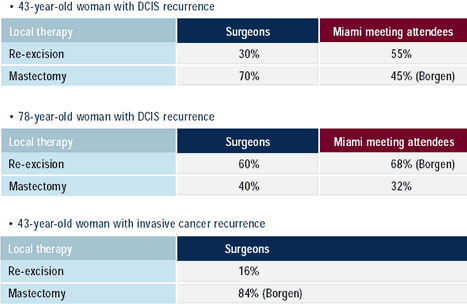| You are here: Home: BCU 4|2002: Program Supplement: Local recurrence

| Therapy
for Local Recurrence |
|
| The following patients had an 0.8 cm,
cribriform DCIS excised with 1 cm margins and were treated
with radiation and tamoxifen. What would you recommend
for a local recurrence one year after the initial therapy?

|
|
There is a significant divergence of opinion for the preferred
surgical approach to the patient with a local recurrence of DCIS.
Surgeons consistently prefer mastectomy when the recurrence is invasive.
Systemic therapy in this situation is controversial, and the NSABP
is considering a trial to evaluate the combination of docetaxel
and capecitabine for patients with invasive recurrences. In the
patient who recurs while on tamoxifen, most Surgeons would continue
some type of endocrine therapy. In the elderly patient, nearly a
third of surgeons would prefer an aromatase inhibitor over tamoxifen.
Harms W et al. Results of chest wall reirradiation using pulsed-dose-rate
(PDR) brachytherapy molds for breast cancer local recurrences.
Int J Radiat Oncol Biol Phys 2001;49(1):205-10. Abstract
McCormick B et al. Local regional recurrence and salvage surgery.
American College of Radiology. ACR Appropriateness Criteria.
Radiology 2000;215 Suppl:1181-92. Abstract
| Local
Management of Primary Breast Cancer |
|
| How many of your breast cancer patients
when presented with the option of breast conservation
choose to have a mastectomy?

Do you ever perform modified radical mastectomy
on an outpatient basis?

Do you ever perform skin-sparing mastectomy?

|
|
Patterns of care studies have demonstrated significant variation
in the use of lumpectomy. Various factors have been attributed to
this observation including physician bias towards mastectomy. Many
academic-based breast surgeons have breast conservation rates in
excess of 80%, and both Miami meeting attendees and faculty believe
that women clearly prefer breast conservation.
Outpatient breast cancer surgery has received a mixed reception
in community practice. About half of surgeons attending the Miami
meeting have performed an outpatient mastectomy, and about two-thirds
of attendees have performed outpatient axillary dissection.
Skin-sparing surgery is now widely accepted as a cosmetically
superior procedure with broad indications; however, about one-quarter
of surgeons attending the Miami meeting do not perform this procedure.
Margolese RG, Lasry JC. Ambulatory surgery for breast cancer
patients. Ann Surg Oncol 2000;7(3):181-7. Abstract
Morrow M et al. Factors predicting the use of breast-conserving
therapy in stage I and II breast carcinoma. J Clin Oncol
2001;19(8):2254-62. Abstract
|
